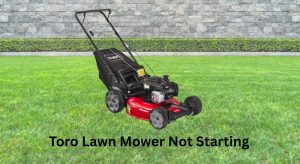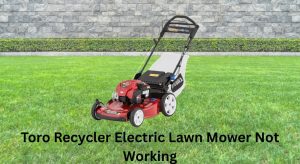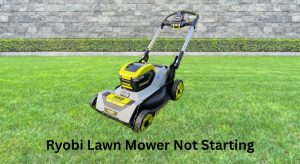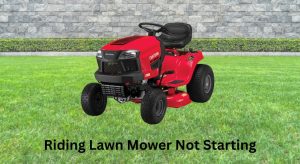When your lawn mower blades will not engage, it’s incredibly frustrating—especially with a yard that’s ready to mow. The quick fix for many mowers is simple: check the bail/engagement lever or PTO switch position, make sure the mower deck is free of heavy grass buildup, and inspect the belt for slipping. For riding mowers, verify that the parking brake is off and the seat switch is being pressed properly.
In this complete troubleshooting guide, you’ll learn the most common reasons blades won’t engage (on push mowers, self‑propelled models, and riding/zero‑turn mowers), how to diagnose and fix each issue, and how to prevent it happening again. By the end, you’ll know exactly what to check—from belts, pulleys, and blade clutches to fuses, PTO switches, and safety interlocks—so you can get back to mowing today.
Common Causes of Lawn Mower Blades Not Engaging
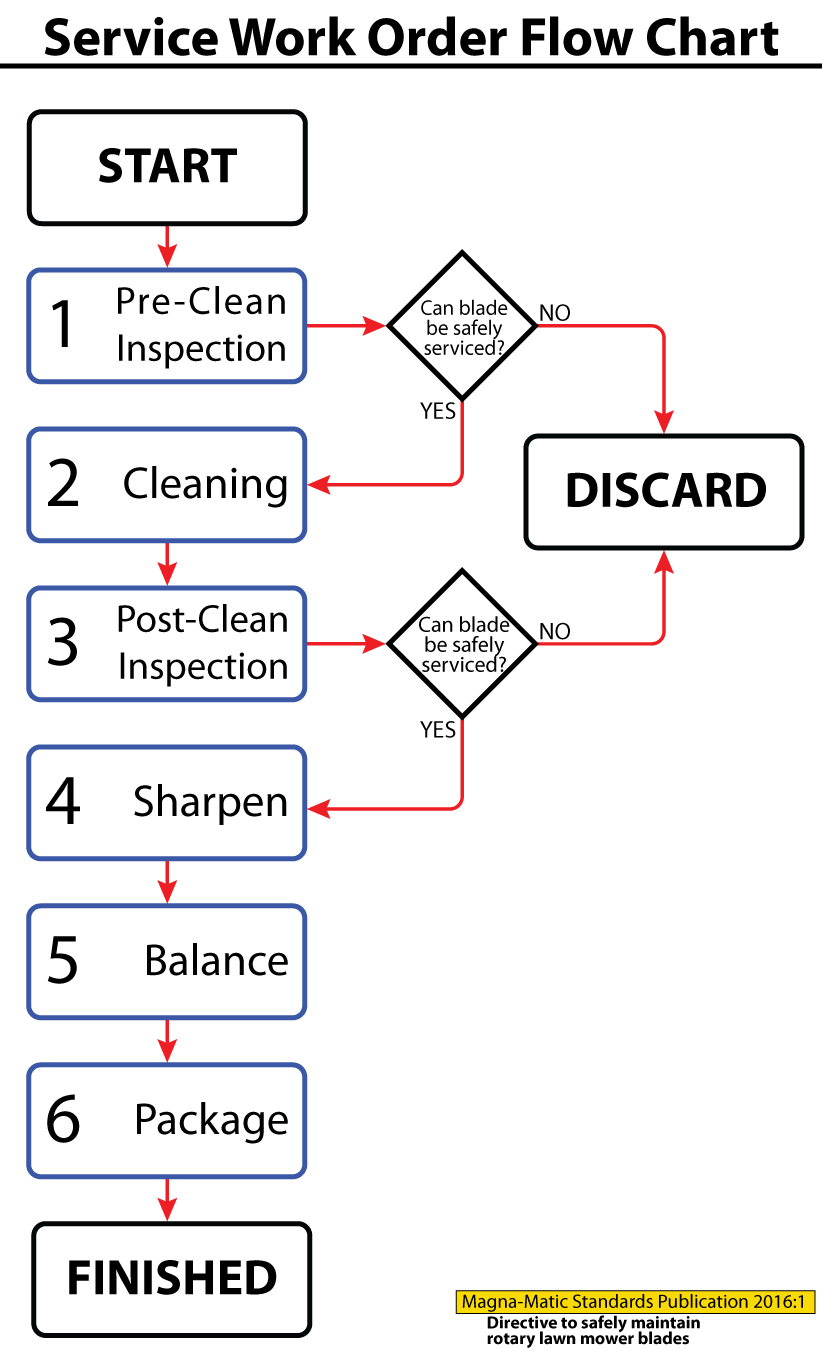
- PTO not activated or interlock not satisfied (parking brake on, not in seat, or handle not pulled)
- Worn, broken, or slipped deck belt
- Stuck or failed idler pulley/tensioner
- Faulty PTO clutch (electric) or engagement cable (manual/mechanical)
- Blown fuse or bad PTO switch (riding mowers)
- Low battery or weak charging system (electric PTO requires >12.2V under load)
- Debris jammed around blades, pulleys, or deck
- Shear key or blade adapter damage (walk-behind)
- Safety switch failure (seat, brake, or blade control)
- Hydraulic or transmission safety logic (zero-turns with control arms out)
- Corroded connectors or bad ground to clutch (riders)
- Deck height set too low causing stall on engagement
- Overloaded engine (wet, tall grass; clogged air filter)
How to Fix Lawn Mower Blades Not Engaging

The steps below apply to three common categories: walk‑behind (manual blade control), riding/tractor mowers (electric or manual PTO), and zero‑turns (electric PTO). Start with the quick safety check and progress to deeper diagnostics.
Method 1: Quick Safety and Interlock Checks
Diagnosing the Issue
Most mowers won’t engage blades if any safety condition isn’t met. Before you assume a mechanical failure, verify the obvious.
Fix Steps
-
Power and posture:
– Riding/Zero-turn: Sit firmly in the seat, release parking brake, set throttle to mid-high, move control arms inward (ZTR), ensure transmission is engaged (not in bypass).
– Walk-behind: Engage the blade control bail/lever fully and hold it. Some models require a firm squeeze. -
Deck and conditions:
– Raise deck one step higher, then try engaging. If it engages, your cut height was too low for current lawn thickness.
– Disengage blades and shut off engine; clean heavy clumps from the deck. -
PTO switch/lever:
– Riding mowers: Confirm PTO switch is pulled up (or lever engaged). Cycle it a few times to clear oxidation.
– If nothing happens, check the inline blade fuse (commonly 10–20A) near the battery or under the dash. -
Battery voltage (electric PTO):
– With engine off, a healthy battery should read ~12.6V. Below 12.2V can prevent clutch pull-in.
– Start engine; measure at battery: 13.8–14.4V indicates charging. If <13.5V, the alternator/stator may be weak; clutch may not engage reliably. -
Safety switches:
– Seat switch: Wiggle in seat while engaging; if blades kick in briefly, suspect the seat switch or wiring.
– Brake switch: Ensure brake pedal is fully released. A misadjusted switch can block PTO.
– Handle/bail cable switch (walk-behind): Ensure the cable pulls the brake/clutch arm fully.
Testing
Try engaging again with proper safety posture. If still no blade action (no sound, no drag on engine), proceed to Method 2.
Method 2: Inspect the Belt, Pulleys, and Tensioner
Diagnosing the Issue
A worn, stretched, or slipped drive belt is the number one mechanical cause of blades not engaging or spinning weakly. Idler pulleys and the tensioner spring keep the belt tight—if they stick, the belt will slip.
Fix Steps
-
Safety first:
– Remove key, disconnect spark plug wire(s) on gas mowers; remove battery negative on riders. For electric mowers, remove safety key/battery pack.
– Allow moving parts to stop fully. -
Access deck:
– Walk-behind: Tilt mower spark plug up to avoid flooding. Inspect under deck.
– Riding: Lower deck to lowest position for access; some decks may need removal. -
Inspect belt:
– Look for cracks, glazing (shiny sides), frayed edges, or missing cogs.
– Check if belt sits deep in pulley grooves (stretched belt). If belt rides high or flips, it’s misrouted or wrong size. -
Check routing and tension:
– Compare routing to the decal under the footrest/hood or your manual. Incorrect routing is common after a belt change.
– Press mid-span: belt should deflect roughly 1/2–3/4 inch under moderate finger pressure. Excess slack = tensioner issue. -
Inspect pulleys:
– Spin each pulley by hand. They should spin freely and quietly. Any grinding or wobble means the bearing is failing.
– Ensure idler arm pivots smoothly; lubricate pivot (use dry lube where appropriate) and check the return spring integrity. -
Correct issues:
– Replace worn belt with OEM-spec. Universal belts often slip or fail early.
– Replace noisy or seized idler pulleys and weak springs.
– Clean heavy debris around pulleys and under belt guards.
Testing
Reassemble guards. Reconnect power. Start engine, set throttle mid-high, and engage blades. If the engine bogs and blades struggle, go to Method 3. If nothing happens and there’s no click on riders, go to Method 4.
Method 3: Free the Blades and Reduce Load
Diagnosing the Issue
Debris jammed around the blade or spindle can block spin or overload the belt. Wet or overgrown grass can stall the deck when engaging.
Fix Steps
- With power disconnected, rotate blades by hand (use gloves). They should turn smoothly. Any binding suggests debris or spindle damage.
-
Scrape deck:
– Use a plastic or wooden scraper to remove caked grass; avoid damaging paint.
– Check discharge chute and baffles. -
Blade condition:
– Bent or nicked blades increase load. Replace if bent; sharpen and balance if dull. -
Spindle check:
– Grab blade ends and gently push/pull. Play or grinding indicates bad spindle bearings—replace or rebuild. -
Engagement approach:
– Start at higher deck height, full throttle (governed mowers), engage PTO, then lower to cut.
– Mow in narrower passes or slower ground speed in tall/wet grass.
Testing
Engage blades. If they now spin normally, resume mowing. If there’s still no clutch engagement sound on a rider (no click), move to Method 4.
Method 4: Electrical PTO Clutch and Switch Diagnosis (Riding/Zero-Turn)
Diagnosing the Issue
On most riding and zero-turn mowers, the blades engage via an electric PTO clutch mounted on the engine crankshaft. Power for the clutch runs through safety switches, a PTO switch, and a fuse/relay.
Fix Steps
-
Check fuse and wiring:
– Locate and inspect the PTO/blade fuse (10–20A). Replace if blown; if it blows again, suspect a shorted clutch coil or chafed wiring.
– Inspect harness from dash to clutch: look for rub-through near frame or deck lift arms. Repair with heat-shrink and loom. -
PTO switch test:
– With key on (engine off), toggle PTO and listen for clutch click.
– Use a multimeter: back-probe the clutch connector. You should see battery voltage (~12V) when PTO is on and interlocks satisfied.
– If no voltage at clutch, test at the PTO switch output. If voltage enters switch but not out, replace the switch. -
Safety interlock path:
– Seat switch continuity: seated = closed circuit on many models (varies by brand). Jumper test for diagnosis only, then restore. Do not mow with bypassed safety switches.
– Brake switch: ensure continuity changes with pedal movement.
– Some models use a PTO relay—listen/feel for click; swap with a similar relay for test. -
Clutch coil test:
– Resistance across clutch coil typically ranges 2–4 ohms (check your manual). Infinite = open coil (replace clutch). Below ~1.5 ohms may blow fuses.
– Apply 12V bench power briefly to clutch leads (with belt clear) to confirm clutch snaps in. If it engages under direct power but not via mower harness, wiring/switch is at fault. -
Air gap adjustment:
– If the clutch gets power but slips, set the clutch air gap. Use feeler gauges to 0.012–0.018 inch at the three adjustment points (brand-specific specs).
– Tighten evenly; recheck gap. Excessive gap prevents engagement. -
Charging system:
– With engine running mid-high, confirm 13.8–14.4V at battery. If lower, the clutch may drop out under load. Test stator/regulator per brand manual and replace faulty parts.
Testing
Reassemble connectors, secure wiring away from hot/moving parts, and test blade engagement. If clutch still won’t engage but wiring and power check out, the clutch is likely worn—replace it.
Method 5: Manual/Mechanical PTO and Cable Systems (Walk-Behind and Some Riders)
Diagnosing the Issue
Some mowers use a cable to pull a brake/clutch arm to engage blades. Stretched cables or seized brake arms prevent engagement.
Fix Steps
- Inspect cable:
– Check for fraying, broken ends, or slack. Adjust at the handle or at the bracket near the engine/deck. - Brake arm and spring:
– Ensure the blade brake arm releases when you pull the bail. Lubricate pivot with light oil.
– Replace weak return spring if the brake drags. - Blade brake clutch (BBC) systems:
– If engine runs but blade won’t engage despite cable movement, the internal BBC may be worn—service or replace per model.
Testing
Pull bail/lever; blade should spin freely with strong engagement. If the engine dies when engaging, see Method 6.
Method 6: Engine Stalls When Engaging Blades
Diagnosing the Issue
If the engine bogs or stalls when engaging, either load is excessive or the engine is weak.
Fix Steps
- Reduce load:
– Raise deck, mow dry grass, engage at full throttle, slow ground speed. - Engine tune:
– Replace/clean air filter, install fresh fuel, clean carburetor jet (if surging), replace spark plug, and check fuel filter. - Check for deck obstructions and blade condition as in Method 3.
Testing
If the engine holds RPM with blades on, the issue was load or tune-related. If not, deeper engine diagnosis may be needed.
Prevention Tips and Maintenance Advice
- Clean the deck after each mow to prevent belt slip and spindle strain.
- Inspect belts every 25 hours; replace at first signs of glazing, cracking, or stretching.
- Lubricate idler pivots and check spring tension each season.
- Keep battery charged; replace weak batteries before they stress the PTO circuit.
- Avoid engaging blades at idle; use mid to full throttle to reduce clutch wear.
- Don’t mow wet or excessively tall grass; take multiple passes.
- Store indoors and keep rodent guards on wiring where feasible.
Pro Tips
- Use OEM belts and clutch parts; slight size/tolerance differences in aftermarket belts cause chronic slip.
- If a fuse blows when engaging PTO, measure clutch coil resistance first—saves time chasing wiring.
- Mark belt routing with a photo before removal; routing mistakes are common.
- Adjust clutch air gap annually; a slipping clutch can blue the pulley and ruin bearings.
- For zero-turns, seat and armrest switches often cause intermittent drop-outs—zip-tie connectors to reduce vibration.
- When tilting a walk-behind, keep spark plug side up to avoid oil flooding the air filter.
- Replace blade bolts to spec torque; loose blades vibrate and damage spindles.
When to Call a Professional
- You smell burning rubber or see smoke from the deck after a new belt—possible pulley seizure or misrouting.
- Electric PTO clicks but won’t hold engagement and voltage tests are borderline—may need clutch replacement and air gap set.
- Repeated blown fuses indicate a shorted clutch coil or chafed harness—requires skilled electrical tracing.
- Spindle has play or grinding—bearing replacement or spindle assembly swap needed.
- Engine consistently stalls at engagement despite tune-up—carburetor rebuild or governor issues.
- Typical costs:
- Deck belt: $25–$80
- Idler pulleys: $15–$40 each
- Electric PTO clutch: $120–$300
- Diagnostic labor: $80–$150/hour
- Warranty notes: Don’t bypass safety switches; that can void warranty. Use OEM parts to maintain coverage.
FAQ
Q: Why do my riding mower blades not engage even though the engine runs fine?
A: Most often it’s a safety interlock (seat or brake switch), a bad PTO switch, a blown fuse, or a worn/slipped deck belt. Start by ensuring the parking brake is off, you’re seated, and the PTO switch is on. Then check the fuse, belt condition, and look for 12V at the clutch.
Q: My blades engage briefly then stop—what’s wrong?
A: This points to a weak battery/charging system, overheating PTO clutch, or a loose safety switch connection. Test charging voltage (13.8–14.4V), inspect wiring/grounds, and set the clutch air gap to spec.
Q: How tight should my mower deck belt be?
A: With proper routing and a healthy tensioner, belt deflection should be around 1/2–3/4 inch under moderate pressure on the longest span. If it’s looser, the idler spring may be weak or the belt stretched.
Q: Can I bypass the seat switch to test the PTO?
A: For diagnosis only, you can temporarily jumper the switch to confirm a fault—but restore the safety system immediately after testing. Operating with bypassed safeties is dangerous and can void warranties.
Q: How do I know if my PTO clutch is bad?
A: Signs include no click when energized, correct voltage present at the clutch with no engagement, high coil resistance (open) or very low resistance (shorted), slipping under load, and burnt odor/blueing. Bench testing with 12V and checking the air gap helps confirm.
Q: Do zero-turn mowers have different engagement issues?
A: They share the same electric PTO components but often add interlocks tied to control arms and parking brake. Ensure arms are in the “operate” position and brake is released before engaging.
Q: My walk-behind won’t spin the blade after winter storage. What should I check first?
A: Verify the blade control cable is pulling the brake/clutch arm fully, free any rust or debris under the deck, sharpen or replace the blade, and confirm the engine isn’t bogging from stale fuel or a clogged jet.
Q: Is it okay to engage blades at idle?
A: No. Engage at mid to full throttle on gas mowers. Low RPM increases clutch wear and can stall the engine.
Alternative Solutions
Sometimes the cost or time to repair isn’t ideal. Consider these options:
| Solution | Pros | Cons | Best For |
|---|---|---|---|
| Replace with OEM belt/pulleys | Restores performance, reliable | Higher cost than aftermarket | Chronic slipping belts |
| Upgrade to heavy-duty PTO clutch | Better heat handling, longer life | More expensive, may need wiring check | Frequent heavy mowing |
| Professional deck rebuild | Fixes spindles, pulleys, alignment | Labor cost | Older mowers with multiple failures |
| New mower purchase | Warranty, latest safety/features | Highest upfront cost | Repeated major failures on old unit |
Get Your Lawn Mower Working Again
Follow this guide step-by-step to fix blades that won’t engage:
– Verify safety interlocks, PTO switch, and battery/charging status
– Inspect and replace worn belts, pulleys, and tensioners
– Clear debris, sharpen/replace blades, and reduce cutting load
– Test the electric PTO clutch, switch, fuse, wiring, and set air gap
– Adjust or replace mechanical cables and blade brake parts as needed
Don’t let “lawn mower blades will not engage” derail your weekend. With a few checks and the right adjustments, most mowers are back in action in under an hour. If you’re still stuck, a professional can quickly diagnose electrical or spindle issues.
Have you fixed your mower using these steps? Share what solved it for you—your experience could help another homeowner get mowing today. Found this helpful? Bookmark it for quick reference next season.


